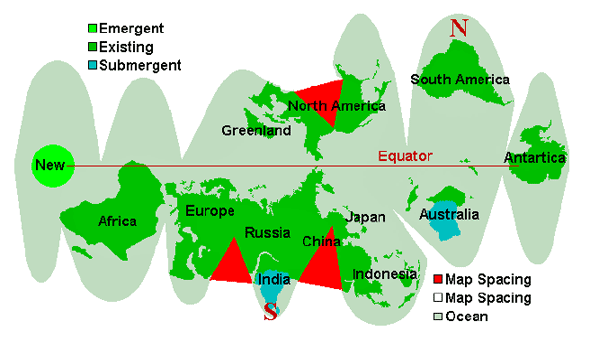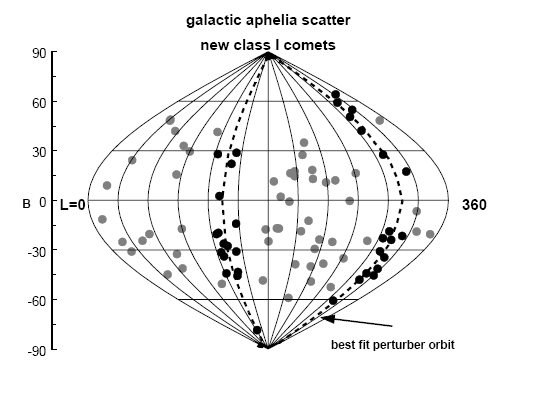|
Prior to the shift, the Earth slows in its rotation, and actually stops. This is recorded in written history and spoken folklore, worldwide, as a long day or night. The explanation for slowing rotation resulting in a stopped rotation during the week prior to the shift is that the passing planet grips the Atlantic Rift magnetically, so the Earth does not turn past this grip. Last Updated December 24, 2002
This part of the globe is centered between land masses that are fairly neutral in magnetic polarization, but lines up over former lava flows from the renting apart of the continents, the mid-Atlantic rift. The Pacific trench lies deeper under the water and its characteristics differ in composition from the newer magma that has arisen during continental drift.
Thus, the Atlantic lava beds are gripped, facing the Sun,
facing the approaching planet coming up from the South along the
rift, and causing both Europe, the Americas, and Africa to be on the
long day side of the Earth.
The Atlantic has clearly been stretched and ripped in the past, with shorelines on both sides of the Atlantic being dragged down such that the remains of forests can be seen underwater off the East Coast of the North American continent, and buried roadways under the waves near Bermuda, and likewise land shelves west of the British Isles. The Atlantic Rift, running the entire length of the Atlantic between the present poles, shows recent tears, and in Africa the rifts increasingly separating the Arab lands from the continent proper are already showing some stress.
During the week of rotation stoppage,
however, this is extreme, so that the Atlantic Rift is under a great
deal of tension and the shorelines are drawn down along both sides
of the Atlantic. Europe and Africa are continually pulled eastward,
by the rotating core. Thus, the Earth moans in her agony, during
this week.
Along the Pacific Rim, plates are being pushed under the Americas, and creating distress in Indonesia as compression of the Pacific is already in process from prior pole shifts and subducting plates are inclined to continue this momentum. The Himalayas, driven high from sea bed material in the past, also show a point of drama, already scripted for India and Australia by past dramas which positioned these plates thus.
Quakes all along the west coast of the
Americas increase, and volcanic activity in Japan and Indonesia
become extreme. India shutters, jerking under the Himalayas in
spurts, creating great panic among her peoples who are already
fearing the worst with the long evening they are experiencing. Tidal
waves are not yet a problem, as the waters normally pooling around
the equator have equalized around the globe, more water at the pole
and less in the equatorial regions.
The dusting with red dust should be considered a warning to take cover, under metal or sod roof structures, out of the wind. The shift cannot be more than a few hours away. The dusting with red dust occurs less than 24 hours, and most likely less than 12 hours.
This depends upon a number of factors, including how well the dust drops through the atmosphere to be deposited on land where the very first evidence will be closely watched for and thus observed. In one location, the first sign of dust may be 18 hours ahead of the shift, and all run in panic to shelters. In another location, dust may not be noticed until heavy, perhaps 6 hours ahead of the shift, a good time to head for the shelters in any case.
The tail sweep will then proceed from red dust
to hail stones just ahead of the shift. A normal roof would protect
from the hail stones, which will be like the hail experienced during
violent windstorms, where hail of ice falls and ruins crop.
There is a great deal of tension that builds between the crust of the Earth and the core of the Earth during the week of rotation stoppage. This tension is released when the core of the Earth breaks with the crust, and moves. However, the core of the Earth drags the crust with it. The pole shift is therefore sudden, taking place in what seems to be minutes to humans involved in the drama, but which actually takes place during the better part of an hour.
There are stages, between which the human spectators, in shock, are numb. At first there is a vibration of sorts, a jiggling, as the crust separates in various places from the core. Then there is a Slide, where the crust is dragged, over minutes, to a new location, along with the core. During the slide, tidal waves move over the Earth along the coast lines, as the water is not attached and can move independently.
The water tends to stay where it is, the
crust moving under it, essentially. When the core finds itself
aligned, it churns about somewhat, settling, but the crust, more
solid and in motion, proceeds on. This is in fact where mountain
building and massive earthquakes occur, just as car crashes do their
damage on the point of impact, when motion must stop.
During the shift, the atmosphere of the Earth does several things, all at once. It drags along with the Earth. It moves as a mass, pushing on air in other places. Thus, even in those places on the Earth which are not moving, during the shift, being pivot points, the air is turbulent. It swirls, as circular motion in air masses is the response to conflicting forces, as seen in the circular motion of tornadoes and hurricanes.
One should not assume a force of winds
above what the world experiences today. Your hurricanes and typhoons
represent what occurs when air masses attempt to move against each
other, given their density and gravity attraction and inertia. These
same factors are in place, are predominant, during the pole shift.
Stay below the Earthís surface, lie low, and tie down everything you
wish to find when itís over.
Tearing of continents is less traumatic than it would seem to humans, who imagine the continents as one plate and think of how lumber resists being torn, metal bends and twists before tearing, and a rope of fibers resists while the fibers snap one by one. Continents are in fact an overlay of many plates, and faults are where most of the plates have fractured in the same place. The continents are attached because some of the plates have not fractured.
Thus, ripping apart of continents is no
more traumatic than subducting or slip-sliding. The land along the
edges generally retains its altitude, as this was determined by the
thickness of the plates, thus its buoyancy on the sea of lava. Solid
land is composed to a great degree from the lighter elements, which
rose to the top during the early cooling of planet Earth, and thus
formed the floating crust.
This thrust can be sudden and
projectile, with the rock flake then crashing down again. Pressure
and release can also create crumpling land where such activity is
not expected. Compressed rock can also drive horizontally, into
nearby soil or space not occupied by anything as dense as itself.
Thus, those in a valley can find rock shooting out of a hillside, or
rock spears shooting under their feet, unexpectedly. Surviving the
mountain building process while in the mountains is precarious, and
not advised.
During the cometís passage, there is such an onslaught to the Earthís upper atmosphere that the available oxygen in places is completely consumed. Heated gas in the cometís tail form petrol chemicals due to the flashes of lightning and intense heat due to passage over open volcanoes, and these petrocarbons rain down, a sheet of flame falling to Earth.
With the atmosphere scattered, these
petrol chemicals descend close to the surface of the Earth before
bursting into flame. A fire storm, killing all beneath it. All this
has been reported in ancient times, as humans observed
accompaniments to the cataclysms. This type of activity sets forests
afire. Where vegetation re-grows, from seeds and roots, many areas
will nevertheless be denuded of vegetation for some time.
During a pole shift, the ocean as a whole is on the move because it stays behind while the crust moves, and thus rolls up on land onto the coastline being pulled under it. This is a flood tide, with the lip of the water being its highest point, rising like a silent tide endlessly on the rise, the wave rolling inland without a crashing back and forth, just a steady progressive inundation. To those at the mercy of such a flood tide, their first thought is to climb above the tide. Soon they are standing on the highest point they can reach, and still the water, flowing inland steadily, rises.
Afloat on a boat or flotsam, they will
be dragged inland with the flow until a reverse slosh begins, the
water flowing back into its bed but in the nature of water during a
slosh, overshooting this other side so that both sides of the ocean
experience this flood tide, alternately, for some days until the
momentum diminishes. When the flood tide recedes, those afloat are
in danger of being dragged far out to sea with the flow, as the
water will rush to its bed unevenly, more rapidly where it can
recede the fastest.
There will be a temporary lowering of
water in the Indian Ocean, which will draw water from where it has
gathered at the South Pole. Where the Pacific shortens dramatically,
the water in the Pacific will find its bowl suddenly smaller, and
will rise along shores on both sides. Given the size of this ocean,
and the ability of her waters to rush over low-lying areas in
Central America or around Australia, tidal waves along the Pacific
coast are not substantially larger than along other coasts.
|

